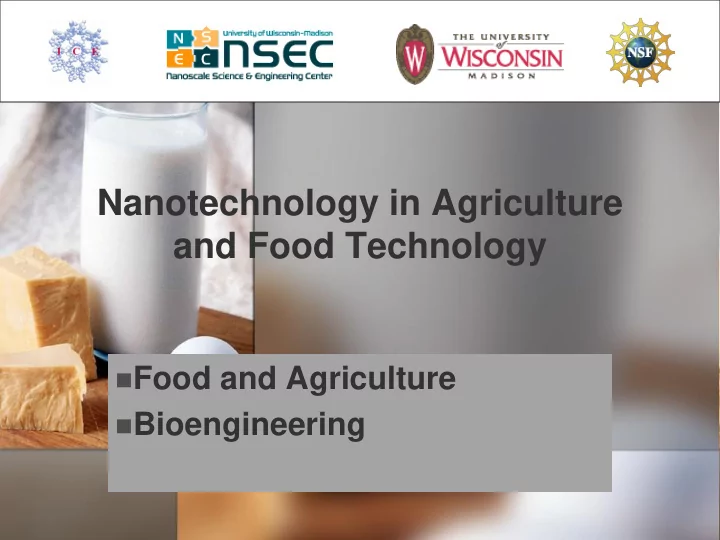

Nanotechnology in Agriculture and Food Technology Food and Agriculture Bioengineering
―Green Science‖ From fish to fungus, trees to turnips, potatoes to paper, green nanobiotechnology (science related to the raising of plants and animals to produce food, feed, fiber or fuel) is about more than pesticides and genetic engineering. How can small science have How can small science have such a big impact? such a big impact? http://en.epochtimes.com/news/6-2-15/38219.html http://www.kjbeath.com.au/photos/fungi%202/Pages/Red_Fungus.html
How Big Is Nano? This is one nanometer! http://www.terressentials.com/exposure.html
http:// www.nano.gov/html/facts/The_scale_of_things.html
Where is Nanoscience in Agriculture and Food Science? image from : http://members.ift.org/NR/rdonlyres/5F641E00-290A-4EB0-93D7-C02171FF5D17/0/1203moraru.pdf
Areas of Nanoscience Research in Agriculture and Food Science On the next few pages we‘ll look at nanoscience research in some of these areas. 1. Pathogen, (something that can cause a disease), and contaminant detection 2. Tracking crops and products 3. Nanodevices for molecular and cell biology 4. Nanoscale materials science and engineering 5. Environmental issues and agricultural waste 6. Educating the public and future workforce http://www.lowimpactliving.com/pages/newsletters/newsletter-green-certifications
1. Pathogen and Contaminant Detection Imagine using nanotechnology to create self-healing materials or coatings that can modify agricultural materials or packaging to prevent microbial contamination; Or sensors which can slow decomposition and detect pathogens before your nose does. http://64.202.120.86/upload/image/news/stopping-the-bacteria-from-talking/stopping-the-bacteria1-.jpg
Eat ‗em Up, Then… Researchers are experimenting with new pathogen-disabling nanoparticles to keep chickens healthy. Nano particles are added to feed and mimic cell surfaces inside the chicken. The tiny pathogens (germs) get confused and bind to the particles instead of real cells, then ―flush‖ - out they go through the digestive system — keeping chickens safer and healthier for human consumption. If it works on chickens, who‘s next? http://www.popularmechanics.com/science/research/4270075.html
Hand-Helds On the other hand, scientists are working on a simple inexpensive hand-held instrument that can detect bacteria in 15 minutes using nanotechnology. http://www.foodproductiondaily.com/news/ng.asp?n=72578-nano-pathogens-sensor http://www.thedarwinpapers.com/oldsite/number6/Number6_files/inspect1.gif
Tracking Crops and 2. Products Traceable nanotags and food quality sensors could Improve food quality, taste and nutritional value Preserve foods and extend nutritional stability http://nano.foe.org.au/image/view/222
Food Poisoning In the wake of widespread food poisoning scares in spinach, tomatoes, cilantro, and peppers, scientists are eager to develop nanosized geotracers that enable users to locate precisely the origin of agricultural products. http://www.eurekalert.org/pub_releases/2006-02/ir-tfp020706.php http://www.braintree.gov.uk/Braintree/environment/food/Food+Poisoning.htm http://www.nfis.com.au/foodbiz/Dec2005/images/food_cafe420.jpg
Nanoscience in Molecular 3. and Cell Biology Nanotechnology is making revolutionary changes within cells which will improve agriculture and the food industry in amazing ways. Develop better soil additives, fertilizers, pesticides, and soil conditioners. Develop surfaces that select, reject or bond to molecules based on nanotechnology.
And… Explore more efficient methods of molecular modification. Identify new agriculturally-derived molecules for industrial and biomedical applications. http://www.jnjgateway.com/home.jhtml?loc=USENG&page=viewContent&contentId=09008b9880ec8e18&parentId=09008b9880ec8c7 http://www.technologyreview.com/read_article.aspx?id=17578&ch=nanotech
Healthy, Yet Tasty, Donuts? With the help of nanoscience, some foods might be taken off of the ‗no - no‘ list: • By using water instead of oil in foods to reduce fat, • And creating textures that feel like high fat foods in your mouth. Wow! I‘m really interested in that nanotechnology! http://www.isrealli.org/another-reason-to-trash-junk-food/
No Kidding? Make food packaging edible. Picture that! Mask unwanted odors and flavors. http://nyc.metblogs.com/archives/images/2007/01/smelly.bmp http://www.amazon.com/Eat-delicious-desirable-successful-packaging/dp/288046773X
Let‘s Have Some Ice Cream! Not only is nanotechnology allowing oil to be replaced by water to make foods, like ice cream, healthier. It is also developing low fat ice creams by decreasing the size of the emulsion particles that give ice-cream its texture. Using up to 90% less of the emulsion and decrease fat content from 16% to about 1%! http://www.mylilypads.com/images/products/me-bath-ice-cream.jpg
Eat Less, Gain More… Nutrients! Some food and beverage products utilize nanosized-encapsulation to make the nutrients more easily absorbed by the organism (increase uptake). http://www.nutralease.com/company.asp
Save Energy, Last Longer Nanoscience can reduce oil use in all types of restaurants, including all fast food establishments, by half. As a result of the large surface area at the nanoscale, it can extend the useful life span of the oil and it heats up more quickly which reduces the energy required for cooking. http://files.nanobio-raise.org/Downloads/nfnaf.pdf http://www.oilfresh.com/of1000.html http://www.comesatradehub.com/images/products/8039972186.jpg
4. Nanoscale Materials Science and Engineering image: http://nanopedia.case.edu/NWPage.php?page=nanoagriculture
Nanomaterials Engineering and materials science at the nanoscale is also improving agriculture and the food industry: Conducting research to better understand the mechanics of nanomaterials such as self- assembly, like the self-assembled capsule on the right. Developing nanomaterials using DNA as a building block, like DNA nanowires, DNA-microelectronic hybrids, bioseparation and biofilms. http://nanotechnologytoday.blogspot.com/2008/04/self-assembled-materials-form-mini-stem.htm l
Environmental Issues 5. and Agricultural Waste Agriculture is utilizing nanotechnology as it works toward the following solutions: Understanding the role of nanoparticles (inorganic and organic) in the movement and uptake of nutrients and pollutants; And the movement and toxicity of nanoparticles in agricultural pollution (dust, feedlot runoff); Reducing or converting animal or plant waste into useful products. http://www.ontariocorn.org/magazine/Issues/2006/12%20December/F1-2b-Stewart-Manure%20Equip-Fig%202b.JPG http://www.tendringdc.gov.uk/NR/rdonlyres/51200D74-A40B-4104-AE7E-BD2FED5F6A0E/0/pollution.jpeg
Nanoscience Reducing Emissions Nanoscience is also helping agriculture and the food industry reduce emissions from production operations.
Nanoscience Reducing Waste Understanding the role of nanoparticles in the global carbon cycle. Designing and developing reusable nanomaterials, such as nanocatalysts, that help reduce waste materials.
Nanotechnology Conserving Water Understanding the role of nanoparticles in soil‘s water retention.
More Nanoscience Help for Soil Create ammonia needed in fertilizer. Create artificial iron in water. Prevent erosion with soil binders that hold soils together. Clean soils using nanoparticles in water that clean the soil as they pass through it. http://www.rpi.edu/dept/chem-eng/Biotech-Environ/LEACH/heap.htm
Fewer Pesticides With Nanotechnology In the near future nanostructured catalysts will be available which will increase the efficiency of pesticides and herbicides, allowing lower doses to be used. http://files.nanobio-raise.org/Downloads/nfnaf.pdf http://www.rsc.org/images/pesticide-300_tcm18-60750.jpg
Did We Mention? Materials science and engineering also uses nanoscience to Enhance photosynthesis, And improve germination. Read more about it by clicking here. http://www.laudu.realtownblogs.com/uploads/_seed_CORB2017.JPG http://www.epa.gov/wed/pages/staff/lackey/pubs/S_I_FIG5.jpg http://iramis.cea.fr/en/meetings/2008TheorieIRAMIS/programme.php
Another Kind of Agriculture Uses Nanoscience Improve fishing practices, breeding and antibiotics. Remove contaminants from water.
Going to the Nano-Market Nanofood market – $2.6 billion 2004 – $7.0 billion 2006 – Projected $20.4 billion 2010 200 companies are currently engaged in nanoproduction, but only a handful of nano food products are market-available now. I wonder what nano food will be on your plate first? Helmut Kaiser Consultancy NWFPA 2007 Expo, Portland OR
Recommend
More recommend